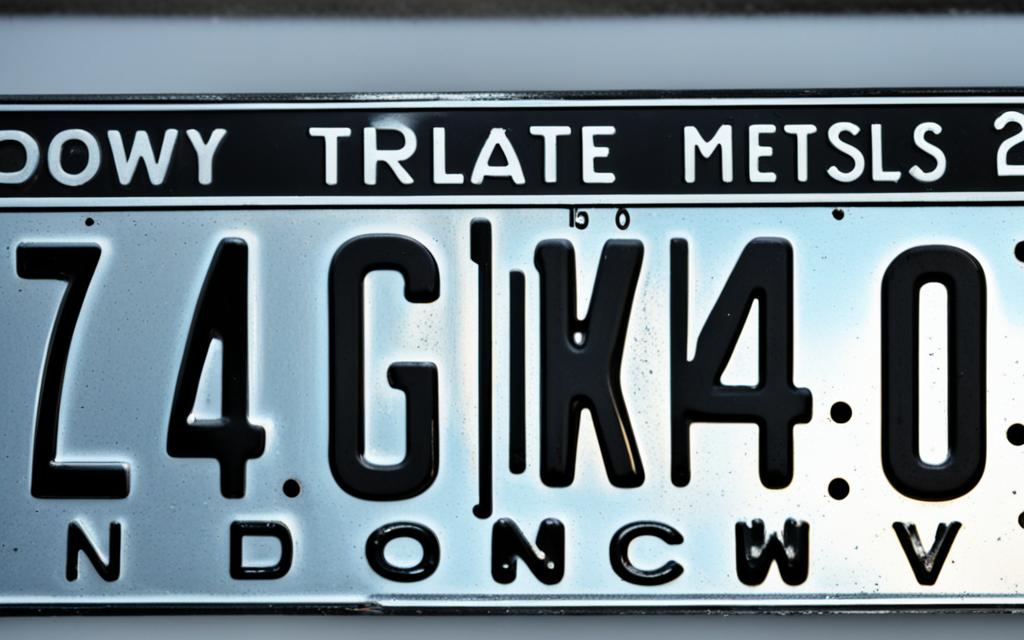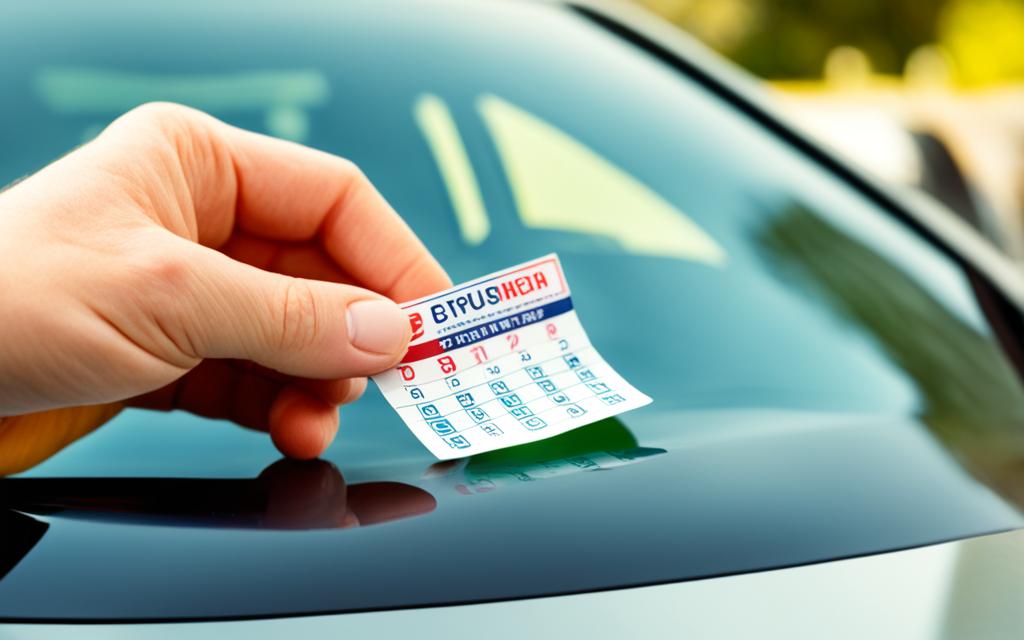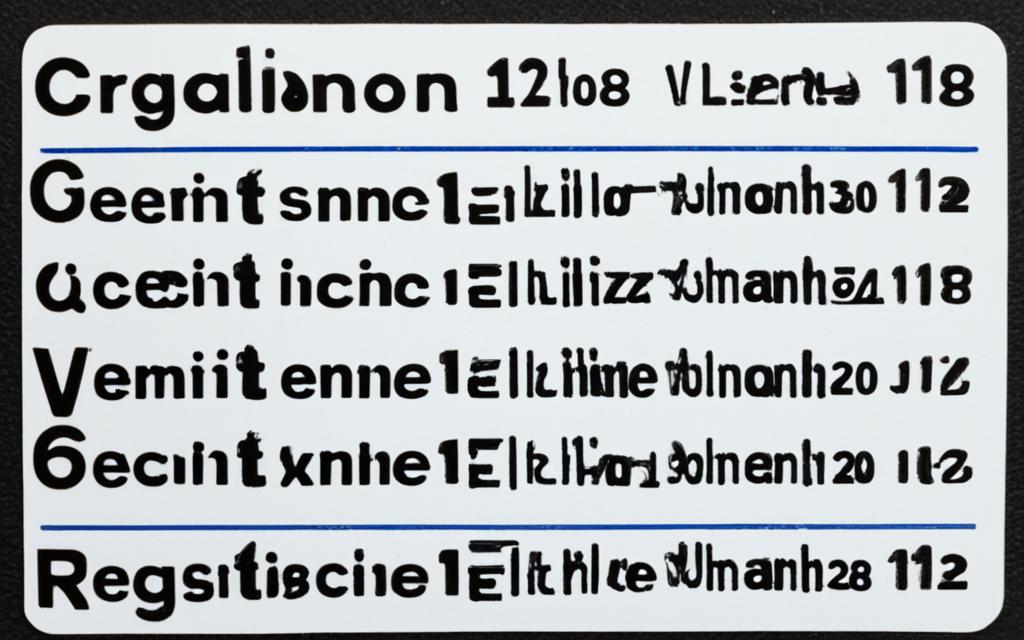Welcome to our comprehensive visual guide on car registration! As a vehicle owner, it’s essential to understand the ins and outs of this important proof of ownership document. In this guide, we will walk you through everything you need to know about car registration, from its appearance to its features and expiration dates.
Whether you are a first-time car owner or have been driving for years, it’s crucial to have a clear understanding of what a car registration looks like and its significance. So, let’s dive in and explore the world of car registrations together!
Key Takeaways:
- A car registration serves as proof of ownership for your vehicle and is essential to legally operate it.
- Understanding the appearance and features of a car registration can help you identify its authenticity.
- Knowing the validity and expiration dates of your car registration is important to avoid potential penalties.
- Renewing your car registration on time ensures the continuous legality of your vehicle on the road.
- In the event of a lost or stolen car registration, taking immediate steps to replace it is crucial.
Understanding Car Registration Documents
When it comes to car registration, understanding the various types of car registration documents is essential. These documents serve as proof of ownership and are required by law for every registered vehicle. In this section, we will explore the different car registration documents and provide insights into their appearance and structure.
Car registration documents can vary in format and layout depending on the state and country. However, there are common elements that can be found on most car registration documents. These elements typically include:
- Vehicle Information: Such as the make, model, year, and color of the vehicle.
- Owner Information: Including the name, address, and contact details of the registered owner.
- Vehicle Identification Number (VIN): A unique identification number assigned to each vehicle.
- License Plate Number: The alphanumeric combination assigned to the vehicle’s license plate.
- Registration Expiration Date: The date until which the registration is valid.
- Registration Number: A unique number assigned to the vehicle’s registration.
- Insurance Information: Details about the vehicle’s insurance policy.
The appearance of car registration documents can range from simple, black and white layouts to more detailed and colorful designs. Some documents may feature additional information such as vehicle emissions data, vehicle weight, and the names of any lienholders.
To give you a visual example, here is a sample car registration document:
| Element | Example |
|---|---|
| Vehicle Information | Make: Honda Model: Civic Year: 2021 Color: Red |
| Owner Information | Name: Jane Smith Address: 123 Main St, Anytown, USA Contact: jane@example.com |
| VIN | 1HGCM82673A123456 |
| License Plate Number | ABC123 |
| Registration Expiration Date | December 31, 2022 |
| Registration Number | 567890 |
| Insurance Information | Insurance Company: XYZ Insurance Policy Number: 123456 |
Understanding the appearance and content of car registration documents is crucial for ensuring compliance with vehicle registration requirements. By familiarizing yourself with these documents, you can easily identify and interpret the information contained within, making it easier to navigate the process of car registration and renewal.
Features and Information on a Car Registration
When it comes to your car registration, it’s important to understand the features and information that are included on this essential document. By familiarizing yourself with the details, you can ensure that your vehicle is registered correctly and in compliance with the law.
1. Vehicle Identification Number (VIN)
The Vehicle Identification Number (VIN) is a unique 17-character code that serves as the fingerprint of your vehicle. It contains important information about the car’s manufacturer, model, and specifications. The VIN can be found on multiple locations on your car, including the dashboard, driver’s side door jamb, and the engine block.
2. Registration Expiration Date
Your car registration is not permanent and comes with an expiration date. It is crucial to renew your registration before it expires to avoid penalties or driving with an invalid registration. The expiration date is often indicated on the registration document, making it easy to keep track of when it needs to be renewed.
3. Vehicle Owner Information
The car registration provides important details about the vehicle’s owner, including their name and address. This information is crucial for maintaining accurate records and ensuring proper communication between the owner and the relevant authorities. Any updates or changes to the owner’s information should be promptly reported to the appropriate department.
4. Vehicle Details
The car registration also includes specific details about your vehicle, such as the make, model, year, and color. This information is important for identification purposes and helps ensure that the proper details are associated with the correct vehicle.
5. State-Specific Information
Depending on the state you reside in, there may be additional state-specific information included on your car registration. This can include emissions standards, specific requirements for certain vehicle types, or additional markings that are unique to your state’s registration process.
| Car Registration Features | Car Registration Details |
|---|---|
| Vehicle Identification Number (VIN) | Unique 17-character code that identifies your vehicle |
| Registration Expiration Date | Date when your registration needs to be renewed |
| Vehicle Owner Information | Owner’s name and address |
| Vehicle Details | Make, model, year, and color of your vehicle |
| State-Specific Information | Additional details or requirements specific to your state |
Understanding the features and information on a car registration is essential for every vehicle owner. It ensures that your vehicle is properly registered, compliant with regulations, and helps authorities identify and track your car. Make sure to review your car registration periodically to ensure accuracy and update any necessary information.
Sample Car Registration – A Visual Example
To help you visualize what a car registration looks like, here is a sample document showcasing its layout, sections, and important information. Take a closer look to gain a better understanding of this essential proof of ownership for your vehicle.
| Section | Information |
|---|---|
| Owner Information | John Smith |
| Vehicle Information |
Make: Toyota Model: Camry Year: 2021 Color: Silver VIN: 12345ABCDE67890 |
| Registration Details |
Registration Number: AB-123456 Registration Expiration Date: 10/31/2023 Renewal Date: 09/01/2023 |
| License Plate | ABC123 |
| Insurance Information | Provider: ABC Insurance Policy Number: 123456789 |
As seen in the sample car registration above, the document contains essential details such as owner information, vehicle information including make, model, year, and VIN, registration details including the registration number and expiration date, license plate information, and insurance details.
Understanding the layout and the information displayed on a car registration is crucial for maintaining compliance with vehicle ownership requirements. Now that you have a visual example of a car registration, you can better navigate the various sections and ensure that your own vehicle registration is accurate and up to date.
Understanding Vehicle License Plates
When it comes to car registrations, license plates play a crucial role. By understanding the format and layout of vehicle license plates, you can gain valuable insights into the registration process and easily identify registered vehicles on the road.
Vehicle license plates are designed to display the unique registration number assigned to a specific vehicle. This registration number serves as an identifier for law enforcement authorities, helping them identify and track vehicles as needed. The layout of license plates in different states may vary, but they typically include a combination of numbers, letters, and additional symbols.
Let’s take a closer look at the typical format of a vehicle license plate:
- Registration Number: The registration number is the most important element on a license plate. It is a combination of numbers, letters, or both, and serves as a unique identifier for each registered vehicle. The format of the registration number can vary by state, but it often follows a specific pattern.
- State or Territory: Most license plates prominently feature the name of the state or territory in which the vehicle is registered. This helps identify the jurisdiction responsible for the vehicle’s registration and can be helpful for law enforcement and other authorities.
- Additional Symbols: Some license plates may include additional symbols or logos that represent specific organizations, events, or causes. These symbols add a unique touch to the license plate design and can provide further information about the vehicle or its owner.
Here’s an example of a typical vehicle license plate:
| Registration Number | State | Additional Symbols |
|---|---|---|
| ABC 123 | New York | (No additional symbols) |
Example of a typical vehicle license plate.
It’s important to note that the specific format and design of license plates can vary by state. Some states may use different colors, fonts, or additional features on their license plates to differentiate between different types of vehicles or to promote specific causes.
Understanding the layout and elements of vehicle license plates can help you easily identify registered vehicles and make the registration process more straightforward. Whether you’re a driver, law enforcement officer, or simply a curious observer, these details can provide useful insights into the world of car registrations.

Validity and Expiration of Car Registrations
Keeping your car registration up to date is crucial to ensure compliance with the law and avoid potential consequences. Understanding when your car registration expires and how long it remains valid is essential for every vehicle owner.
Car registrations have varying expiration dates depending on the jurisdiction and registration type. In most cases, registrations are valid for a specific period, typically ranging from one to two years. To determine the exact validity period of your car registration, you can refer to the expiration date indicated on the document issued by your local Department of Motor Vehicles (DMV) or relevant authority.
Driving with an expired or invalid car registration is illegal in most states. It can result in penalties such as fines, registration suspension, or even the impounding of your vehicle. Additionally, operating a vehicle with an expired registration may nullify your insurance coverage, exposing you to financial risks in the event of an accident or other incidents.
Regularly renewing your car registration is essential to maintain its validity and ensure that you can legally drive your vehicle. Remember to renew your registration before the expiration date to avoid any lapses or interruptions in your registration status.
| Registration Type | Validity Period |
|---|---|
| Private Passenger Vehicles | 1-2 years |
| Motorcycles | 1-2 years |
| Commercial Vehicles | Varies by weight class and usage |
| Trailers | 1-2 years |
It’s important to note that registration expiration dates may vary by state and vehicle type. Some states may have specific requirements for certain types of vehicles, such as commercial trucks or trailers, which may have different validity periods. To ensure compliance, always consult your local DMV or relevant authority for accurate and up-to-date information regarding your car registration.
Renewing Car Registrations
Renewing your car registration is an essential task that ensures your vehicle remains legally registered and valid. By staying up-to-date with your registration, you can avoid potential fines or penalties. Let’s take a closer look at the process, requirements, fees, and necessary documents for renewing your car registration.
Process of Renewing Your Car Registration
The process of renewing your car registration typically involves a few simple steps:
- Check the renewal notice: The DMV (Department of Motor Vehicles) will usually send you a renewal notice in the mail, indicating that your registration is due for renewal. Make sure to keep an eye out for this notice.
- Prepare necessary documentation: Gather all the necessary documentation required for the renewal process, such as your current registration, proof of insurance, and any other required forms. Each state may have specific requirements, so it’s essential to check your state’s DMV website for the exact documents needed.
- Choose the renewal method: Depending on your state, you may have multiple options for renewing your car registration, such as online, by mail, or in-person at a local DMV office. Select the most convenient method for you.
- Pay the renewal fee: Pay the required renewal fee, which may vary depending on factors such as your vehicle’s weight, fuel type, and any additional local fees. The renewal notice or the DMV website will provide you with the exact fee amount.
- Receive your new registration: Once you’ve completed the renewal process and your payment has been processed, you will receive your new registration either electronically or by mail.
Requirements and Necessary Documents
When renewing your car registration, you will generally need the following:
- Valid identification: Bring a valid form of identification, such as a driver’s license or state ID.
- Current registration: Bring your current registration document, as it may be required as proof of ownership.
- Proof of insurance: Depending on your state, you may need to provide proof of insurance coverage. Check your state’s requirements for the specific documents accepted.
- Renewal notice: If you received a renewal notice in the mail, bring it along as it may contain important information.
- Payment: Be prepared to pay the renewal fees, which can vary depending on your state and vehicle specifications.

Renewing your car registration on time is crucial to ensure you can continue legally driving your vehicle. Remember to check your state’s specific requirements and deadlines for renewal. By following the renewal process and providing the necessary documents and fees, you can maintain a valid and current car registration without any hassle.
Replacing Lost or Stolen Car Registrations
If you’ve misplaced or had your car registration stolen, it’s important to take immediate action to replace it. Fortunately, the process of obtaining a replacement car registration is relatively straightforward. In this section, we’ll guide you through the necessary steps, forms, and fees associated with replacing a lost or stolen car registration.
- File a police report: If your car registration has been stolen, it’s important to file a police report as soon as possible. This will serve as documentation and help protect you from any potential fraudulent use of your registration.
- Contact your local DMV: Reach out to your local Department of Motor Vehicles (DMV) office to inform them about your lost or stolen car registration. Provide them with the necessary information, such as your vehicle details and identification.
- Complete the appropriate forms: The DMV will provide you with the necessary forms to request a replacement car registration. Fill out the forms accurately and completely, ensuring that you provide all required information.
- Pay the replacement fee: There may be a fee associated with obtaining a replacement car registration. The DMV will inform you of the exact amount and accepted payment methods. Be prepared to pay the fee to complete the replacement process.
Once you’ve completed these steps, the DMV will process your request and issue you a replacement car registration. It’s important to keep the replacement registration document in a safe place to avoid any further loss or theft.
If you’re unsure about the specific procedures or forms required by your state or jurisdiction, be sure to consult your local DMV or visit their official website for detailed information. Every state may have slight variations in the replacement process, so it’s essential to follow the guidelines provided by your local DMV.
Remember, having a valid car registration is crucial for legal compliance and proving ownership of your vehicle. By promptly replacing a lost or stolen car registration, you can ensure that you have the necessary documentation on hand while driving.
| Documents Required | Forms | Replacement Fee |
|---|---|---|
| Proof of identity | DMV-provided replacement form | $X.XX (varies by state) |
| Proof of vehicle ownership | Police report (if applicable) | |
| Proof of address |
Transferring Car Registrations
If you’re involved in buying or selling a used car, it’s important to understand the process of transferring car registrations to ensure a smooth transition of ownership. Transferring car registrations involves transferring the legal rights and responsibilities of the vehicle from the current owner to the new owner. This ensures that the new owner becomes the official registered owner of the vehicle and takes over the associated obligations, such as insurance and vehicle taxes.
Transferring car registrations typically requires a series of paperwork, including:
- Proof of ownership: The current registered owner must provide documents proving their ownership of the vehicle.
- Signed title: The current registered owner must sign the title to transfer the ownership to the new owner.
- Sales agreement: If the car is being purchased, a sales agreement should be drawn up to outline the terms and conditions of the sale.
- Application for transfer: The new owner needs to complete an application form for the transfer of the car registration.
Additionally, some states may require a vehicle safety inspection or emission test to be completed before transferring the registration.
It’s crucial to follow the specific requirements and procedures set by your state’s Department of Motor Vehicles (DMV) or relevant licensing authority when transferring car registrations. Failure to complete the transfer correctly or submit the necessary documents may result in delays, fines, or complications with insurance coverage.
The following table provides an overview of the transfer process for car registrations in some of the most populous states in the United States:
| State | Transfer Process |
|---|---|
| California | Contact the DMV for the necessary forms, submit transfer paperwork, pay fees, and surrender the license plates. |
| Texas | Complete a vehicle transfer notification online, submit necessary forms, pay fees, and surrender the license plates. |
| Florida | Submit a completed title transfer application, provide proof of insurance, pay fees, and surrender the license plates. |
| New York | Complete the transfer section on the vehicle title, apply for a new title, pay fees, and surrender the license plates. |
Note: The transfer process may vary depending on the specific requirements of your state or jurisdiction. It’s essential to consult your local DMV or licensing authority for accurate and up-to-date information.
By following the proper procedures and completing the necessary paperwork, you can ensure a seamless transfer of car registration from one owner to another. Remember to notify your insurance provider about the change in ownership to avoid any gaps in coverage.
Updating Information on Car Registrations
Sometimes, it may be necessary to update the information on your car registration. Whether you’ve recently moved and need to update your address or have changed your name, it’s important to keep your car registration details accurate and up to date. Here’s what you need to know about updating your car registration information:
- Gather the necessary documents: Before updating your car registration details, make sure you have the required documents on hand. These may include proof of address, such as a utility bill or lease agreement, and legal documentation for name changes, such as a marriage certificate or court order.
- Contact your local DMV: Reach out to your local Department of Motor Vehicles (DMV) office to inquire about the specific process for updating the information on your car registration. They will provide you with the necessary forms and instructions to proceed.
- Complete the required forms: Fill out the forms provided by the DMV accurately and legibly. Be sure to double-check all information before submitting the forms to ensure accuracy.
- Submit the necessary paperwork: Once you’ve completed the required forms, gather any supporting documents and submit them to the DMV. This may involve visiting their office in person or mailing the documents. Follow the instructions provided by the DMV for the most convenient method.
- Pay any applicable fees: Depending on the updates you are making to your car registration, there may be associated fees. Be prepared to pay any applicable fees at the time of submission.
By following these steps and submitting the necessary documents, you can ensure that your car registration information is updated accurately and reflects your current address or name. It’s important to note that each state may have slightly different requirements and processes, so be sure to check with your local DMV for specific instructions.
| Documents | Updates | Fees |
|---|---|---|
| Proof of address (e.g., utility bill, lease agreement) | Updating address | Varies by state |
| Legal documentation (e.g., marriage certificate, court order) | Updating name | Varies by state |
Ensure that you promptly update your car registration information to avoid any potential issues with law enforcement or receiving important notifications related to your vehicle. Keeping your car registration details up to date is an essential responsibility for every vehicle owner.
Conclusion
In conclusion, understanding what a car registration looks like is essential for every vehicle owner. By familiarizing yourself with the details and features of this important document, you can ensure that your vehicle remains properly registered and in compliance with the law.
Remember to regularly update and renew your car registration to avoid any issues and maintain a valid proof of ownership. Keeping your registration up to date is crucial for ensuring that you’re legally allowed to operate your vehicle on the road.
Whether it’s updating your personal information, transferring ownership, or replacing a lost or stolen registration, familiarize yourself with the necessary procedures to keep your car registration accurate and valid.
FAQ
What does a car registration look like?
A car registration is typically a small card or document with various information about the vehicle and its owner. It usually includes details such as the vehicle identification number (VIN), license plate number, registration expiration date, owner’s name and address, and any relevant stickers or seals.
What are the key details and features of a car registration?
The key details and features of a car registration include the VIN, license plate number, registration expiration date, owner’s information, and any required stickers or seals. These details are essential for proving ownership and legally operating a vehicle.
Can you provide a sample car registration as a visual example?
Unfortunately, we cannot provide a specific sample car registration as it may vary depending on the state or country. However, you can easily find visual examples online or contact your local Department of Motor Vehicles (DMV) for a sample car registration specific to your region.
How long is a car registration valid for?
The validity of a car registration varies based on the state or country. In most cases, car registrations are valid for a specific period, usually one to two years. It is important to renew your car registration before it expires to ensure your vehicle remains legally registered and avoid any penalties or fines.
How do I renew my car registration?
To renew your car registration, you typically need to submit a renewal form with updated information and pay the required fees. The specific process may vary depending on your state or country. It is advisable to check the website of your local DMV or contact them directly for detailed instructions on how to renew your car registration.
What should I do if I lose my car registration?
If you lose your car registration, you will need to apply for a replacement. The process for replacing a lost or stolen car registration varies depending on your state or country. Generally, you will need to fill out a replacement form, provide proof of identification, and pay a fee. Contact your local DMV for specific instructions on replacing a lost or stolen car registration.
Can I transfer my car registration to a new owner?
Yes, you can transfer your car registration to a new owner when selling or buying a used vehicle. The process for transferring car registrations may vary depending on your state or country. Typically, both the buyer and seller will need to complete a transfer form, provide necessary documentation, and pay any applicable fees. It is important to follow the specific instructions provided by your local DMV to successfully transfer the car registration.
How can I update information on my car registration?
If you need to update information on your car registration, such as a change of address or name, you will need to contact your local DMV. They will provide you with the necessary forms and instructions for updating the information on your car registration. Keep in mind that there may be specific requirements and fees associated with updating car registration details, so it is important to follow the provided guidelines to ensure accuracy and validity.








